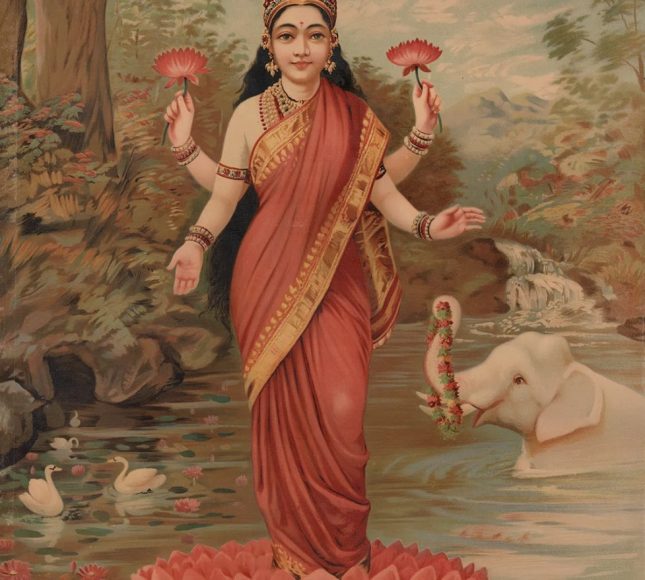LAKSHMI (LACHHMI or LAKHMI) All the gods make obeissance to Lakhmi (Lakshmi). (Bhairo M. 3, p. l54) The Lord, in whose house there is ever youthful Lachhmi (Lakshmi). (Malar Namdev, p. 1292) Lakshmi is the goddess of fortune. She is one of the gems (Ratan), which sprang out from the ocean, when it was churned by the gods and demons. She became the consort of Vishnu. Because of her resplendent beauty and surpassing loveliness, she is called Padma, Kamla or Kavala.
She is represented as sitting at the feet of Vishnu in his repose on the snake Ananta. She is often pictured as standing on a lotus (Padam or Kamal). She is also called Sri or the goddess of prosperity. She is said to have four arms. See : Vishnu
References :
1. Kohli,Surindar Singh ed,Dictionary of Mythological References in Guru Granth Sahib 1993
Lakshmi, also spelled Lachhmi or Lakhmi, is one of the principal deities in Hindu mythology, revered as the goddess of wealth, prosperity, and fortune. She is also associated with beauty, fertility, and abundance, making her one of the most widely worshipped goddesses across India and beyond. Lakshmi is considered the consort of Lord Vishnu, the preserver within the Hindu trinity (Trimurti), and thus she plays an integral role in sustaining life and harmony in the universe.
Symbolism
Lakshmi is often depicted in Hindu iconography as a radiant figure seated or standing on a lotus flower, which symbolizes purity and spiritual enlightenment. She is usually portrayed with four arms, representing four aspects of human life:
- Dharma (righteousness and duty)
- Artha (wealth and material prosperity)
- Kama (desires and pleasures)
- Moksha (liberation and spiritual freedom)
She holds lotus flowers in her hands, emphasizing her connection to purity and growth, while coins flow from one of her hands, signifying the bestowing of wealth and abundance to her devotees.
Legends
Lakshmi’s stories are often intertwined with those of Vishnu, as she accompanies him in all his avatars. For example:
- In the Ramayana, Lakshmi manifests as Sita, the devoted wife of Lord Rama.
- In the Mahabharata, she appears as Rukmini, the chief consort of Krishna.
These manifestations reflect her role as a nurturer, guiding and supporting Vishnu in his divine missions.
A famous myth involving Lakshmi is the Samudra Manthan, or the churning of the ocean of milk. In this story, she emerges during the churning, resplendent in her beauty, and is immediately accepted by Vishnu as his eternal companion.
Worship and Festivals
Lakshmi is worshipped during numerous festivals, but Diwali (the festival of lights) is especially dedicated to her. On this day, devotees honor Lakshmi to invite wealth and prosperity into their homes by lighting lamps, performing prayers, and cleaning their living spaces to signify the welcoming of good fortune.
Lakshmi embodies not only material riches but also spiritual wealth, reminding her followers that true prosperity comes from living a balanced and righteous life.



